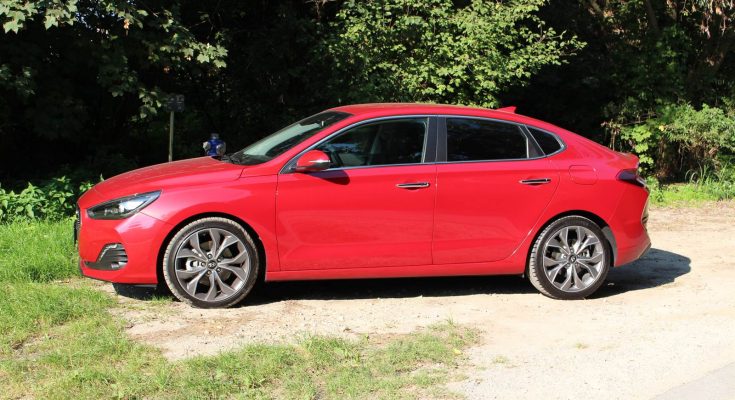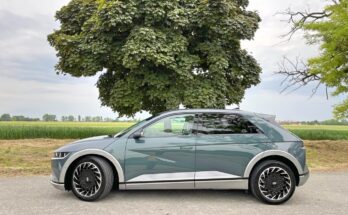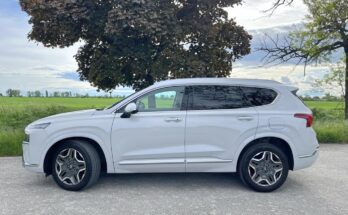The Hyundai i30 of the third generation has been on the road since 2017. In addition to the usual hatchback and station wagon body versions, the manufacturer decided to take a risk and offers a liftback body. I wonder if its sporty shape was also reflected in the driving characteristics and if the practical side did not suffer as a result.
From the outside
The fact is that design sells. First of all, the customer must like the car, and only then solve the technology and other parameters. At the first look at this car, I have to say that the job was done. The sporty cut rear part of the vehicle gives it a completely different design dimension. The large spoiler is part of the bodywork and smoothly follows the LED signature of the rear lights, which extend modernly to the sides of the bodywork. The rear-narrowing cabin is accentuated by the muscular rear fenders, which optically widen the car from the rear. The high lid of the fifth door creates a relatively small area between the lights, which the designers have somewhat forcefully filled with the car brand and the name "Fastback". Personally, I would rather place the brand lower and move the model name to the left to the level of the i30 inscription… The black unpainted plastic on the bottom evokes a diffuser with a real exhaust tip sticking out, which is almost an exception these days.
From the side, the low body profile that descends even further towards the back (3 cm lower than the hatchback), the sharply beveled windshield and the relatively short rear section stand out. The large surfaces of the doors are interrupted only by a sharp overhang extending from the front fender above the handles and a gentle indentation in the lower part. 18" wheels (225/40 R18) reserved only for the Fastback type nicely fill the fenders and underline the sporty appearance of the car.
The front part differs from the hatchback only in the dark background of the headlights. It looks a little settled and is more suited to a conservative hatchback or station wagon.
Overall, however, I consider the exterior to be very successful.
Inside
In the interior, I did not expect changes compared to other versions of the i30, nor was it necessary. The interior upholstery of the doors is tastefully and nicely done. The only thing that bothered me was the smooth plastic around the door handle and window controls, which feels cheap and will be prone to scratches. The slim dashboard is made of both soft and hard plastics with the same surface pattern. The steering wheel has an interestingly shaped center and high-quality buttons. The modern 8" infotainment display is placed as if additionally above the pair of central vents, which, by the way, do not have the same shape. I was pleased that Hyundai still retains the ability to control basic infotainment functions with classic buttons and does not rely only on the touchscreen.
Similarly, the two-zone climate control panel is located below, which is followed by a relatively subtle central tunnel. In my opinion, it could have been placed a little higher, but otherwise there is nothing to blame. The automatic transmission selector is surrounded by other buttons, including the Start-Stop switch on its right-hand side, which I would have liked to have been placed closer to the driver. The automatic handbrake was already part of the equipment of the previous generation i30, the practical AutoHold function is a welcome novelty. I appreciated the deep compartment under the air conditioning panel with the possibility of wireless charging of the mobile phone and the luxuriously opening door.
I don't really like the traditional blue backlighting of the instruments and buttons, which could have been replaced with white. However, this little thing is only a matter of taste.
The seats have distinctive sides made of artificial leather, a fabric center with a delicate pattern and offer the option of extending the seat. At first glance, they promise a pleasant sitting.
Driving
When opening the doors, I was impressed by their high weight and the premium sound when closing them. The sealing on their perimeter is rich and painstakingly worked out. The seat is quite low and therefore getting in is a bit difficult. In addition, the roof is located 3 cm lower than in the hatchback, which does not add much to the comfort of boarding. But that's not a criticism, I'm just pointing out that it's a relatively low car and you have to take that into account.
The seats are rather stiffer and their lateral guidance is not only aesthetic but also functional. They will not be suitable for overly wide figures. The position of the seat suited me and therefore I did not miss the possibility of adjusting its inclination. On the contrary, the extension of its length did not suit me. The backrest was high enough and the four-way adjustable headrest was also excellent. Traditionally, I was not impressed with the too high lumbar support of the Hyundai brand…
But I was satisfied with the steering wheel. It has a pleasantly thick rim, a tastefully designed center and quality buttons. The scope of its setting is extremely wide and must suit absolutely everyone. The instrument panel is classic, but clear. I don't have any comments about the central TFT display, which shows the data of the on-board computer and the options for setting assistance and other systems.
The pedals are in the right place, the left leg rest can withstand even a bear's paw. The combination of the position of the seats and the steering wheel enables a downright sporty sitting position with the legs extended forward.
I have no reservations about ergonomics. The automatic selector and controls are close at hand, and infotainment is similarly conveniently controlled via the touchscreen and the buttons around it. The central armrest is soft, sliding and in the right position.
Despite the narrow side windows, the view to the sides is sufficient. The rear-view mirrors are long but a bit narrow. The front window is sharply tilted and therefore the view is sometimes problematic, e.g. on high-placed traffic lights. The tribute to the design is the tank visor at the back. The space above the head and to the sides is not to be given away, but adequate for the lower middle class.
Except for the location of the lumbar support, I have no reservations about the seat behind the wheel and the driver's space, and I would call it almost perfect.
On the road
Under the hood, the company's four-cylinder with a volume of 1353 cm 3 , a maximum power of 103 kW at 6000 revolutions and a torque of 242 Nm between 1500 and 3200 revolutions arrived quietly and without vibrations. It is still the most powerful power unit in the i30 model, if of course we do not take into account the i30N .
The engine is powerful enough for its class, although of course it cannot be called an "asphalt ripper". It is pleasantly twisty and provides a smooth pull up to the limiter. As is typical for current low-volume supercharged engines, there is no speed-dependent power gradation, and there is also no power peak.
I see the problem in the rather long response to stepping on the accelerator, which I estimate to be up to 1 and a half seconds. It manifests itself mainly when trying to accelerate rapidly, when it is necessary to count on it and press the pedal a little earlier. This phenomenon does not occur during normal smooth driving and smooth acceleration. On the contrary, I recommend the machine to the best that is currently offered. It is a self-made 7-speed dual-clutch transmission. It shifts gently and with feeling, without jerking and jerking at low revs. I have no reservations about the logic and speed of the shift. I rarely got it stuck, and only when I let off the gas (e.g. when approaching an intersection) and after a while pressed it again. In this case, I noticed some hesitation in the transmission when indicating the correct gear. Sports mode can eliminate similar cases to a large extent, because it tries to maintain higher revolutions and thus a lower gear.
I was also bothered by the reluctance of the car to accelerate in a corner. The question is, what part does the transmission play in this and what is the already mentioned delay in the engine's response to the gas pedal. Going through a sharp corner under the gas is simply a problem in this car. Unless, of course, you take the shifting into your own hands and start shifting manually. There are no missing levers under the steering wheel, the gearbox responds to commands quite briskly, and you will suddenly find that this car is no stranger to sporty driving and that the chassis could also handle a more powerful engine. However, when shifting manually, I was missing the displayed gear, which was replaced by the recommended one.
In city traffic, I appreciated the relatively light steering, but I would have liked more sharpness (I counted about 2.6-2.7 revolutions between extreme positions). Thanks to the turning diameter of 10.6 m, the car is excellently handled even in narrow streets. Parking is also assisted by a rear camera with dynamic guidance. I was surprised by the flexible chassis, which, despite its noticeable stiffness, easily filters out normal unevenness even on 18" wheels with 225/40 tires. Consumption in the city depends on traffic and ranges from 5 to 9 liters.
I was satisfied with the steering even when driving on district roads. The power steering offered a bit more resistance when it was further from the center position, but overall the steering felt very natural. In sports mode, it stiffens, but that makes its naturalness disappear a little. The chassis provided much more support in the corners than I expected and it was possible to drive it in a downright dynamic manner. When cornering, the car leans only gently. I tested its limits in familiar sections several times at higher and higher speeds until I gave up. You could feel the weight of the car coming out of the corner, but the chassis simply ignored it. It is interesting that I did not notice the work (or flashing light) of the stabilization system even during very fast cornering. It is likely that I was far from the limit…
Lane Keeping Assist can automatically carve out sharper turns, but for my taste it tries too hard to assert itself when fighting with the driver. In addition, the booster loses its naturalness and begins to act artificially.
The damping of unevenness, except for particularly sharp holes on the road, was still at an excellent level even at higher speeds. I was extremely satisfied with the brakes, their fine dosage and effect suited me. During normal brisk driving, gasoline consumption was around 6.2 l/100 km, and between 9 and 10 liters during particularly sporty driving.
I didn't notice any significant problem on the highway. The car is insulated above average from aerodynamic noise. However, the chassis could be better insulated from the tires. At a speed of 130 km/h, the engine rotates at 2500 revolutions in seventh gear, when it is still exemplary quiet. I summarized the revolutions at other speeds in the following table:
| Speed in km/h | revolutions/min |
| 110 | around 2100 |
| 120 | about 2300 |
| 140 | 2750 |
Engine power is sufficient up to a speed of 140 km/h, after which its smaller volume starts to be felt. The body is not sensitive to side winds and the car is stable even at higher speeds. The steering seems a little overpowered at higher speeds, but there is no play around the center position and it is not necessary to make direction corrections. On the expressway at a speed of 100 to 110 km/h, the consumption can be kept up to 6 liters, on the highway at a speed of 130 to 140 km it rises to 7.
I thoroughly enjoyed driving the i30 and returned it with an average consumption of 6.9 l/100 km. Except for the delay in the engine's reaction to the gas pedal, there is little to complain about the car. It scores with excellent driving characteristics, but still maintains a high level of comfort.
Practical side, equipment, price
The liftback body also made a difference on the practical side. The luggage compartment is very accessible and spacious (450/1351 liters), but it has a high loading edge. The double bottom offers additional practical compartments. You will also be pleased with the space for transporting longer objects, hooks and the standard supplied net for securing objects. The car is equipped with a spare wheel.
Families with children will appreciate the easily accessible IsoFix mounts and the plastic trim on the back of the front seats. The ventilation vents were also not forgotten at the back. I see the problem in the space on the back seats, where, at my height of 185 cm, I could not sit "behind myself" without touching the knees of the front seats and the top of the roof at the same time. However, shorter figures will not have a problem, the rear seats are comfortable with sufficiently high backrests.
Storage spaces and folders are at the average level of the class. I appreciated the excellent range of the built-in radio and, above all, the excellent sound of phone calls transmitted via bluetooth. I already know infotainment from other vehicles of the Hyundai/Kia concern. It is clear and fast, although the graphics seem a bit outdated. I did not use the built-in navigation thanks to Android Auto/Apple Car Play support.
The equipment of the tested Style car is rich enough. Its base price with the 1.4 T-GDI engine is EUR 21,690. Our car was additionally equipped with an automatic transmission (1850 EUR). Personally, I would complete the equipment with the Safety Pack + package, which includes, among other things, an excellently functioning adaptive cruise control with an assistant for driving in a convoy.
I consider the price to be acceptable within the competition, moreover, it is currently supported by a bonus worth EUR 1500.
Verdict
The Hyundai i30 is an excellent car in every body variant. However, the Fastback brought something that the somewhat conservative model lacked, namely an exceptional and sporty design. I was extremely satisfied with the car and I would certainly not leave it out when choosing a model in the lower middle class.




